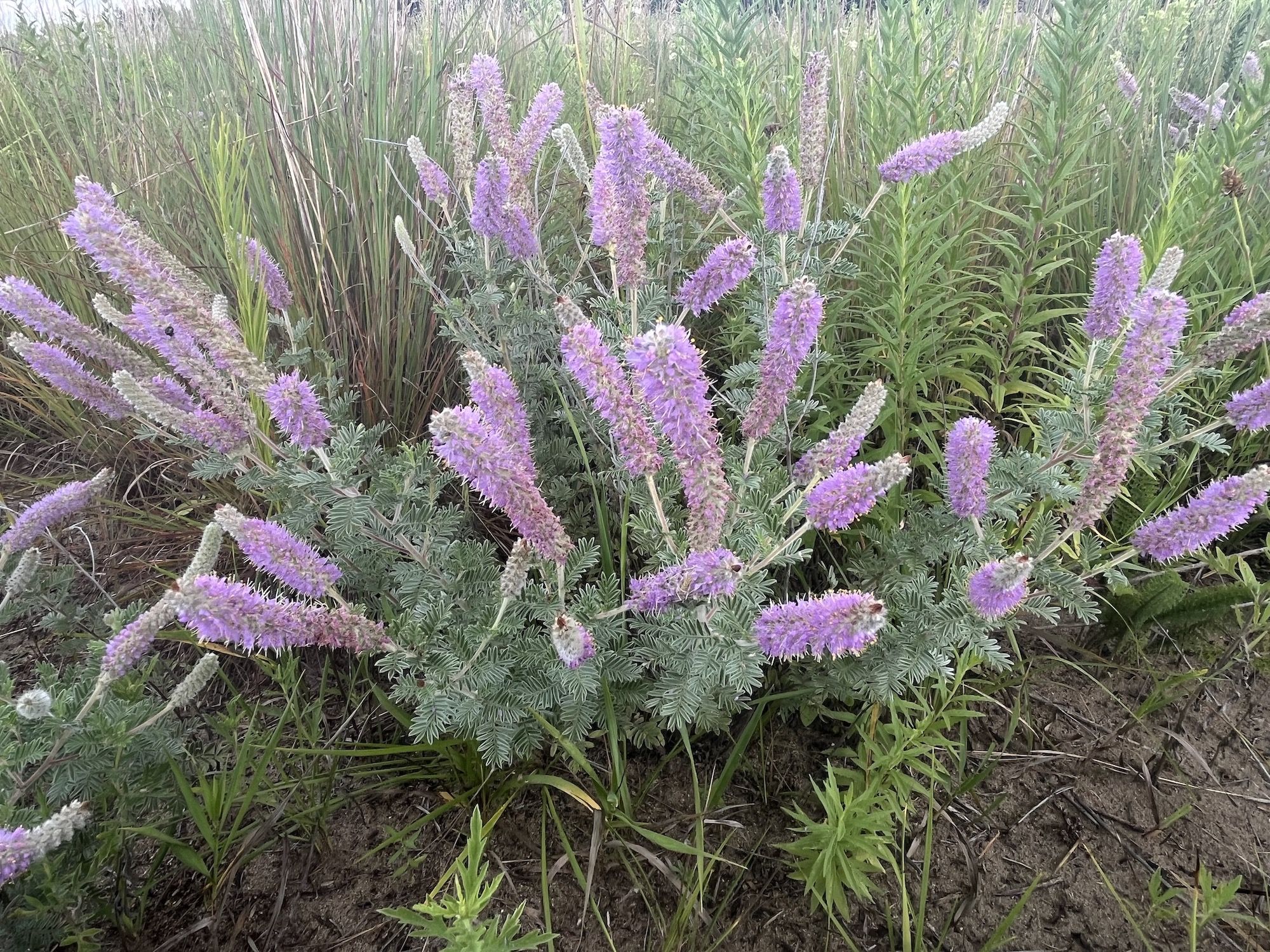Luuk Clark is a Prairie Steward and Pinnated Grouse advocate. He thanks Laura Walters of the Tallgrass Prairie Center and John Pearson of the Iowa DNR for helping him find a nearby location to photograph Silky prairie clover for this post.
Silky prairie clover (Dalea villosa) is a bit of a nomadic species relying on sandy, sparsely vegetated places. In Iowa it may be mainly associated with ancient post-glaciated delta systems and watersheds surrounding the Cedar River.
My first time seeing it in Iowa was on a sandy “blowout” further east than the current range indicates. This does not surprise me as the changing of the natural landscape in Iowa has extirpated a plethora of our native species, and thus, our knowledge of where things historically could be found are lost with the upturned soil and disappearance of the prairie that gives Iowa its rich heritage. Its historic presence in Iowa was always considered “infrequent” even in earliest records, such as Wesley Greene’s 1907 book Plants of Iowa: A Preliminary List of the Native and Introduced Plants of the State, Not under Cultivation.
Pre-bloom flowerheads are about the size of one’s pinky and are white-green before opening, as shown here:

That said, silky prairie clover could be considered fortunate in being relegated to poor soils unfit for farming. Sand hills, alluvial sand bars reworked into outwash sites blown by wind, grazed by bison, and burned late summer would have given this species an optimal homestead.
Nowadays, this species is classified as endangered in Iowa, making it a treat to come across, let alone see in-person within our state. It is more of a Great Plains species, only known natively east of the Mississippi in Wisconsin and a sole location in Michigan.
Silky prairie clover tends to disappear with the onset of vegetative competition on sandy sites.

The charm of this plant lies in its form, feel, and flower. No more than two feet high, it develops a great clump branching out in every direction, as if putting out feelers to test for a new direction to migrate. The leaves and stem are unique in being densely pubescent or hairy, giving it a soft silvery lining on its deep green foliage.
As early as June you can see the spikes of the flowers forming a bundle of white. The blossoms open from late July into August, starting from the bottom and working its way to the top of the plant. Usually, the blooms are a pink to lavender color, rarely white.

A myriad of bee species love this flower and are the primary pollinators. It is not able to self-pollinate, so it relies on these helpful “bizzybodies” to help it reproduce. The floral smell is wonderful and reminds you of pure clover honey. Lakota tribes used the leaves and flowers to help with swollen throats. In some areas of the country, this species is used to stabilize sandy, erosion prone areas.
The seeds of silky prairie clover ripen quickly in September, turning dark brown or gray before falling.

Post-bloom, this species rapidly takes on skeleton-like features, making it hard to find after it loses its leaves.

My earliest memory of this “fugitive species” was seeing it for the first time walking the eastern prairies in Colorado. I had scared a Pinnated Grouse (Tympanuchus cupido pinnatus) with her brood on a gently sloping hill and stood astounded—as one is wont to do with this umbrella species of the prairie. As I climbed the hill to see where they had flushed to, I was greeted by the sight of 30 or more blooming silky prairie clover over the rise, a double hitter for me!
Now, when I see this rare Iowa prairie clover, I reflect on what was and what could someday be again for Iowa. It’s a promise that not all the wild beauty is gone in the most forlorn places and an inspiration in its fleeting blossoms.
Even on a cloudy day like when I took this photo, the blooms almost glow.

Citations:
Bizecki RobsonDiana. 2014. Mutualistic and antagonistic networks involving the rare silky prairie-clover (Dalea villosa var. villosa) and its co-flowering plants and insect visitors. Botany. 92(1): 47-58. https://doi.org/10.1139/cjb-2013-0231
Brakie, M. 2016. Plant Guide for silky prairie clover (Dalea villosa). USDA-Natural Resources Conservation Service, East Texas Plant Materials Center. Nacogdoches, TX 75964.
Manitoba Conservation Wildlife and Ecosystem Protection Branch. 2007. Manitoba species at risk-hairy prairie-clover Dalea villosa. Manitoba Conservation Wildlife and Ecosystem Protection Branch Environment Canada. Winnipeg, Manitoba Canada.
Minnesota Wildflowers. Dalea villosa (Silky Prairie Clover).
Moerman, Daniel. (2014). Ethnobotany in Native North America. 10.1007/978-94-007-3934-5_8580-2.
Smith, B. 1998. COSEWIC status report on the hairy prairie-clover Dalea villosa var. villosa in Canada. Canadian Wildlife Service, Environment Canada. Ottawa, Ontario Canada


1 Comment
Seeing this amazingly beautiful (great photos!!) endangered native wildflower...
…reminds me that long ago, there was a small state fund that was specifically designated for acquiring and protecting Iowa land that contained rare species and ecosystems. Some very important conservation land was protected as a result. Hard to believe in 2024, but I swear it’s the truth.
PrairieFan Sat 5 Oct 1:59 PM